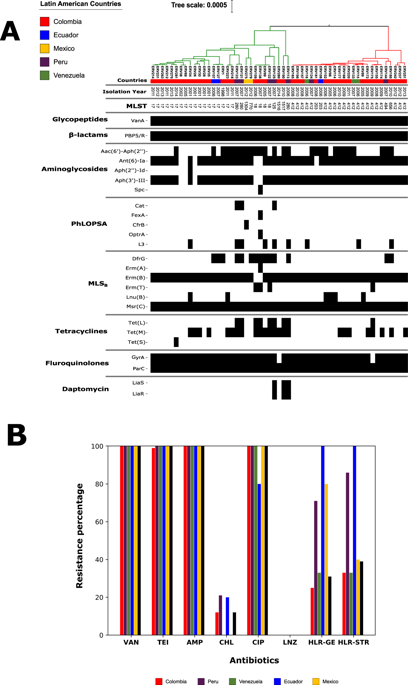Scientific Reports ( IF 3.8 ) Pub Date : 2020-03-27 , DOI: 10.1038/s41598-020-62371-7 Rafael Rios 1 , Jinnethe Reyes 1, 2 , Lina P Carvajal 1 , Sandra Rincon 1 , Diana Panesso 1, 2, 3 , Aura M Echeverri 1 , An Dinh 2, 3 , Sergios-Orestis Kolokotronis 4, 5 , Apurva Narechania 4 , Truc T Tran 2, 3 , Jose M Munita 2, 3, 6, 7 , Barbara E Murray 2, 3, 8 , Paul J Planet 4, 9 , Cesar A Arias 1, 2, 3, 6, 8 , Lorena Diaz 1, 2, 6

|
Little is known about the population structure of vancomycin-resistant Enterococcus faecium (VREfm) in Latin America (LATAM). Here, we provide a complete genomic characterization of 55 representative Latin American VREfm recovered from 1998–2015 in 5 countries. The LATAM VREfm population is structured into two main clinical clades without geographical clustering. Using the LATAM genomes, we reconstructed the global population of VREfm by including 285 genomes from 36 countries spanning from 1946 to 2017. In contrast to previous studies, our results show an early branching of animal related isolates and a further split of clinical isolates into two sub-clades within clade A. The overall phylogenomic structure of clade A was highly dependent on recombination (54% of the genome) and the split between clades A and B was estimated to have occurred more than 2,765 years ago. Furthermore, our molecular clock calculations suggest the branching of animal isolates and clinical clades occurred ~502 years ago whereas the split within the clinical clade occurred ~302 years ago (previous studies showed a more recent split between clinical an animal branches around ~74 years ago). By including isolates from Latin America, we present novel insights into the population structure of VREfm and revisit the evolution of these pathogens.
中文翻译:

拉丁美洲耐万古霉素粪肠球菌(VREfm)的基因组流行病学:重新审视全球VRE人口结构。
关于拉丁美洲(LATAM)耐万古霉素的粪肠球菌(VR Efm)的种群结构知之甚少。在这里,我们提供了在5个国家/地区从1998- 2015年回收的55个代表性拉丁美洲VR Efm的完整基因组学表征。LATAM VR Efm人口分为两个主要的临床分支,没有地理聚类。使用LATAM基因组,我们重建了VR Efm的全球人群包括从1946年到2017年的36个国家的285个基因组。与先前的研究相比,我们的结果显示动物相关分离株的早期分支,临床分离株进一步分为A分支中的两个子分支。进化枝A高度依赖重组(占基因组的54%),进化枝A和进化枝B之间的分裂估计发生在2,765年前。此外,我们的分子钟计算表明,动物分离株和临床进化枝的分支发生于502年前,而临床进化枝的分裂发生于302年前(以前的研究表明,临床动物分支之间的分裂最近发生于约74年前。 )。通过包括来自拉丁美洲的分离株,我们提供了有关VR人口结构的新颖见解Efm并重新审视这些病原体的进化。











































 京公网安备 11010802027423号
京公网安备 11010802027423号